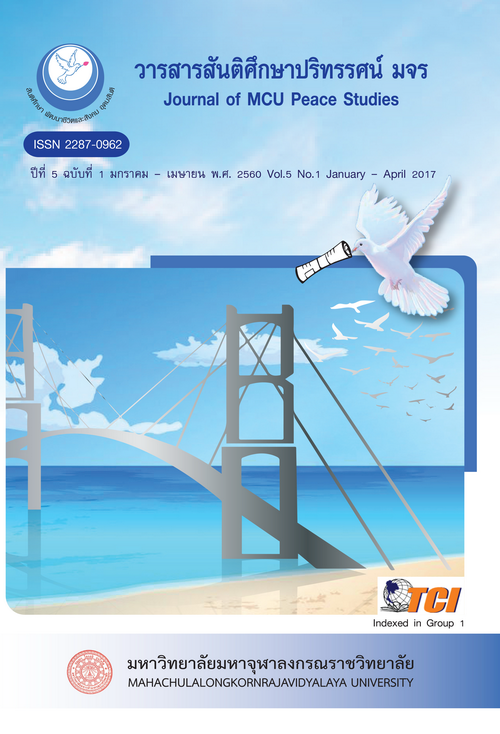Buddhism Culture for Peaceful Coexistence of Thai-Mon Ethnic Group in Ratchaburi Province
Main Article Content
บทคัดย่อ
The objectives of this research were 1) to study culture of Thai-Mon ethnic group in Ratchaburi province and 2) to study Buddhism culture for peaceful coexistence of Thai-Mon ethnic group in Ratchaburi province. The research method was qualitative method, study with - 7 key informants. The tool for collecting data was as the structured interview, and analysis by content analysis technique.
The findings of this research are as follows:
1. The culture of Thai-Mon ethnic group in Ratchaburi province was to settle down at Ban Pong and Photharam district. Although, Thai-Mon ethnic group in Ratchaburi province believed in the Buddhism deeply and offer sacrifices to a spirit Thai-Mon Ethnic groups emigrated to stay in Thailand and got about customs, tradition and the culture to hold inherit ministerial strictly. The some part of Mon culture, it was influential to Thai-society such as music culture got Mon orchestra consisting of five groups of wood and percussion instruments to use in funeral rites or the dialect language, Thai society got some Mon language to use in Thai language too such as the words are that “krung”, “nie”, “klong” that means “the capital city”, “mister”, “channel” etc. In the aspect of literature, it was found that Thai society got influential from Mon culture in about the plot, that is Rachathiraj story which about Mon annals and the aspects of Thai-customs and traditions such as Song-Kran festival or Water festival, both of Thai and Mon people were regarded as New Year festival. As for the dressing original of Mon, it was chintz cheered wearing by the elder man wore a Panung, which call that “Sarong” and wear a shirt leisurely. The dressing of women wore a Panung, which call that “Ka-Nin” or “Nin”, it was resemble with wearing skirt of Thai woman but it was long covered the heel and wearing a shirt leisurely. In the time when they go to temple or religious ceremony, they used a breast cloth and popularity to put up long hair lower than behind. The aspects of house found that Mon people believed about the gable putting by laying the gable on east–west direction, in other that they put the gable take the sun and there were the ghost pillars or the main post pillar at the first pillar position on the east direction by the ghost doors was the door of house at the west direction which was the door upstairs that was not porch supports for prepare to take a corpse get off a house in accordance with belief of ancients.
2. Buddhism culture for peaceful coexistence of Thai-Mon ethnic group in Ratchaburi province found that the spiritual culture or nonphysical culture, which a history about the trust of human for intellect and beautiful mind such as morality, Buddhist doctrine and traditionalism. It was indicated on rites or ceremony which was instrumental for helping the creation the solidarity to society. Because the religion of Buddhism culture was Dharma principle that encourage for Peaceful Coexistence such as Sangahavatthu, Dhamma for sympathetic joy or social solidarity for Peaceful Coexistence, feature that give alms (giving, sharing, sacrifice, generousness). Peyyavajja (kindly speech, convincing speech). Atthacariya (useful conduct, rendering services of doing well for others). Samanattata that behave oneself properly in all circumstances, equality consisting in impartiality. The principles virtuous existence, the Dhamma adhere of adults, feature that Matta or kindheartedness, were inspired by kindness for others). Karuna or Kindness (compassionate, wish for helping others from suffering. Mudita or sympathetic joy, Ubegkha that behave equality consisting in impartiality) and Sappurisadhamma; Sattaburut of Dhamma or Dhamma of good person, feature that Dhammannuta (knowing the cause), Atthannuta (knowing the self), Mattannuta (knowing to be proportion), Kalannuta (knowing how to choose and keep time), Parisannuta (knowing the assembly; knowing the society) and Puggalannuta (knowing the individual; knowing the different individuals).
Article Details
ทัศนะและความคิดเห็นที่ปรากฏในบทความในวารสาร ถือเป็นความรับผิดชอบของผู้เขียนบทความนั้น และไม่ถือเป็นทัศนะและความรับผิดชอบของกองบรรณาธิการ ยินยอมว่าบทความเป็นลิขสิทธิ์ของวารสาร


